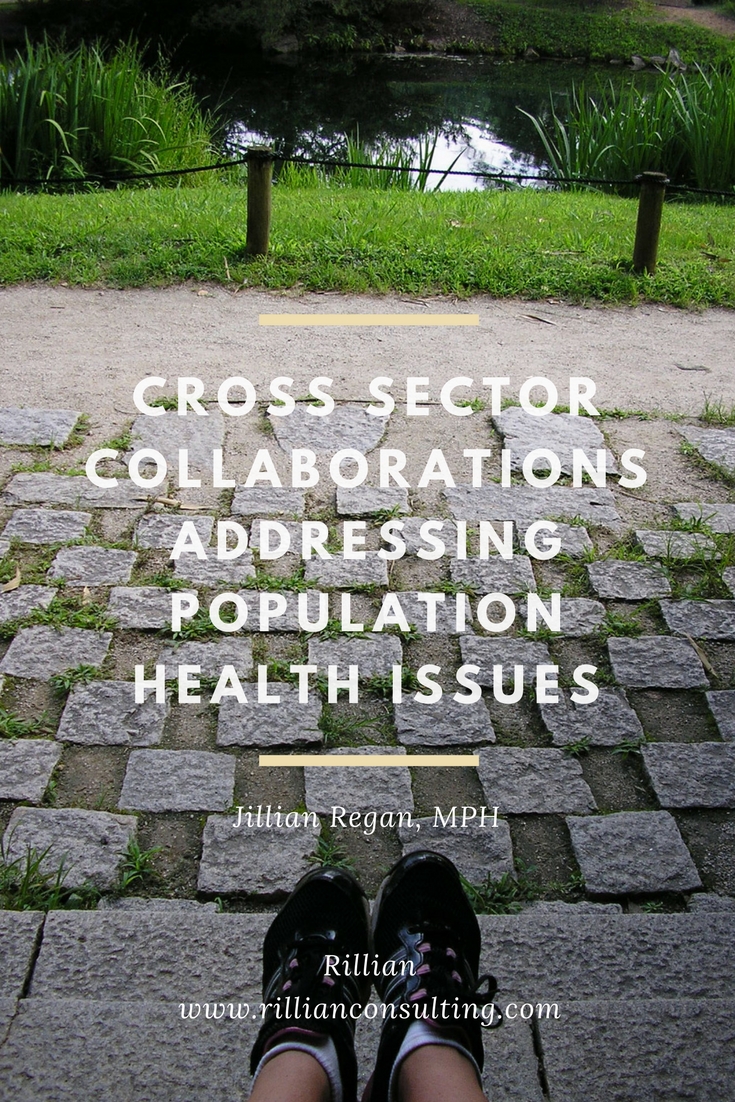Cross sector collaborations can be a great way to address population health issues. There are myriad ways and types of cross sector collaborations as well as a variety of types of organizations involved in cross sector collaborations. Here are a few examples of current or recent collaborations.
Examples
Engaging Youth in Building a Culture of Health — Collaboration between the National 4-H Council, the Robert Wood Johnson Foundation, the national Cooperative Extension System, and Local Health Councils
The National 4-H Council is partnering with the Robert Wood Johnson Foundation, the national Cooperative Extension System and local Health Councils in 1,000 different communities in the U.S. with a focus on engaging youth in to promote a culture of health in their communities. (1).
The 4-H organization is a youth development organization that focuses on empowering youth to by providing youth with experiences that help to develop critical life skills. The Robert Wood Johnson Foundation works to improve health and health care, with an emphasis on creating a culture of health.
This new partnership will focus on involving youth in addressing top public health priorities in cross-sector collaborations between the youth and community members, local public health organizations, businesses, government entities, and non-profit agencies. Three main focus areas of this partnership will be designing a network to promote health and wellness in communities, creating and disseminating tools for healthier communities, and launching a training curriculum for local community advocates. The network, tools, and curriculum created from this partnership will be able to be applied to other communities in the U.S. (1)
Opioid Addiction Treatment through Telemedicine in Rural Communities– a Cross-Disciplinary Team
The opioid addiction epidemic is a serious and severe population health issues. Many different organizations are working to address this issue. One way is through cross sector collaboration. An example is a cross disciplinary team of psychiatrists, a nurse practitioner, and a social worker from the University of Maryland School of Medicine and health system working with a non-profit organization to develop and implement opioid telemedicine programs in rural communities as part of Robert Wood Johnson Foundation’s Clinical Scholars program.(2)
Collaborators:
- Eric Weintraub, MD, director of substance abuse services at University of Maryland School of Medicine (UMSOM)
- Seth Himelhoch, MD, professor of psychiatry at UMSOM
- Jewell Benford, LCSW-C, a lead social worker at UMSOM,
- Marian Currens, director of chemical dependency, University of Maryland Medical System
- Wells House, a non-profit providing recovery services to community members battling drug and alcohol dependencies in Hagerstown, MD
NACCHO – FDA – Health Departments Collaboration to offer a Mentorship program to improve and standardize Retail Food Regulatory programs
Having robust, standardized retail food protection programs can improve food safety inspections and help to reduce the risk and occurrence of foodborne illness outbreaks in retail food establishments.
The National Association of City and County Health Officials (NACCHO) and the Food and Drug Administration (FDA) connect retail food regulatory programs (RFRP) that are looking to improve and standardize their retail food protection services with mentors from RFRP’s that are already experienced with implementing the FDA’s Retail Food Regulatory Program standards.(3) The FDA’s RFRP standards are a set of 9 standards that focus on the improving the design and management of existing RFRP’s so that they can better provide their services to reduce risk factors that contribute to foodborne illnesses in their jurisdiction. (4)
In addition to facilitating the mentorship experience NACCHO and the FDA provide funding for both the mentee and the mentor RFRP’s. Other assistance is also provided, such as sharing of policies, procedures, tools, and technical assistance to help RFRP’s implement the FDA’s RFRP standards to better be able to improve food safety in their community or jurisdiction.(5)
Conclusion
Learning about different cross sector collaborations has hopefully given you some ideas for how your organization or an organization you work with can collaborate with other organizations in different sectors to address a population health issue.
Organizations collaborating in cross sector collaborations can come from a variety of industries, ranging from the federal government, national non-profits focused on supporting local health officials or creating a culture of health, university hospitals, health departments, and more. Cross sector collaborations can be a great way to address population health issues.
Do you have any examples of cross sector collaborations working to improve community health issues, or have you or your organization been a part of a cross sector collaboration that you would like to share about? Then leave a comment below!
Jillian Regan, MPH is a consultant at Rillian. She enjoys providing technical assistance to organizations, so that the organization can better serve its clients, customers, patients, or other stakeholders. Connect with her by email at Jillian.Regan@RillianConsulting.com or Twitter (@JillianReganMPH) or LinkedIn.
Follow Rillian on Facebook to get updates on articles like this one or updates about current projects, like a bicycling survey!
Sources:
- National 4-H Council and the Robert Wood Johnson Foundation Partner to Empower Youth in Creating Healthier Communities. Robert Wood Johnson Foundation. Retrieved 9/14/17 from https://www.rwjf.org/en/library/articles-and-news/2017/09/national-4-h-council-and-rwjf-partner-to-empower-youth-in-creating-healthier-communities.html
- Felix, K. New Leaders Use Telehealth—and Teamwork—to Tackle Opioid Use. Robert Wood Johnson Foundation. Retrieved 9/26/17 from https://www.rwjf.org/en/culture-of-health/2017/09/new-leaders-use-telehealth-to-tackle-opioid-use.html
- National Associated of City and County Health Officials (NACCHO). NACCHO Mentorship Program. Retrieved 11/5/17 from https://www.naccho.org/programs/environmental-health/hazards/food-safety/mentorship
- Food and Drug Administration (FDA). 2015. Voluntary National Retail Food Regulatory Program Standards – Introduction. Retrieved 11/5/17 from https://www.fda.gov/downloads/Food/GuidanceRegulation/RetailFoodProtection/ProgramStandards/UCM372399.pdf
- National Associated of City and County Health Officials (NACCHO). Retail Food Program Standards Flyer. Retrieved 11/5/17 from https://www.naccho.org/uploads/downloadable-resources/Retail-Program-Standards-Mentorship-Program-Flyer.pdf
